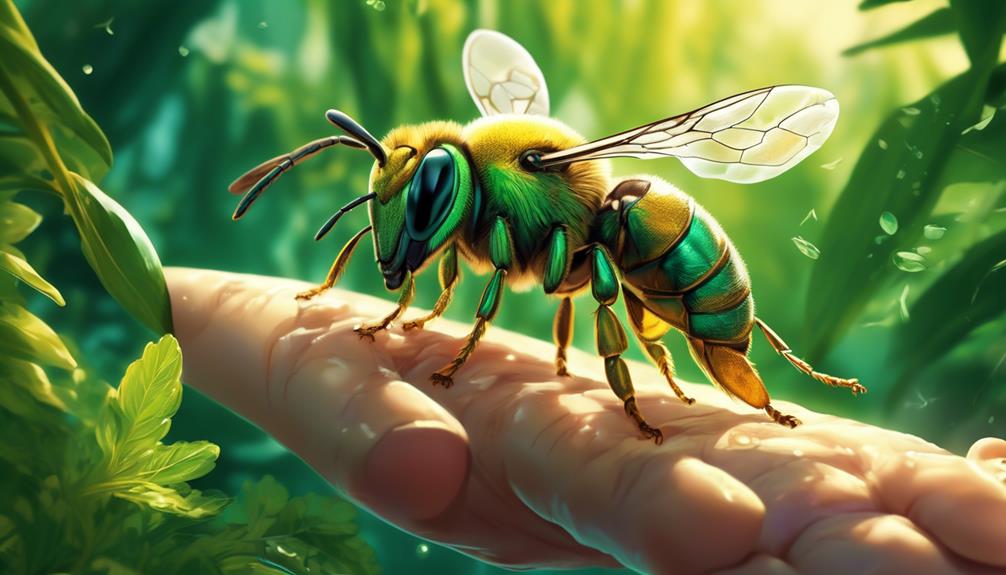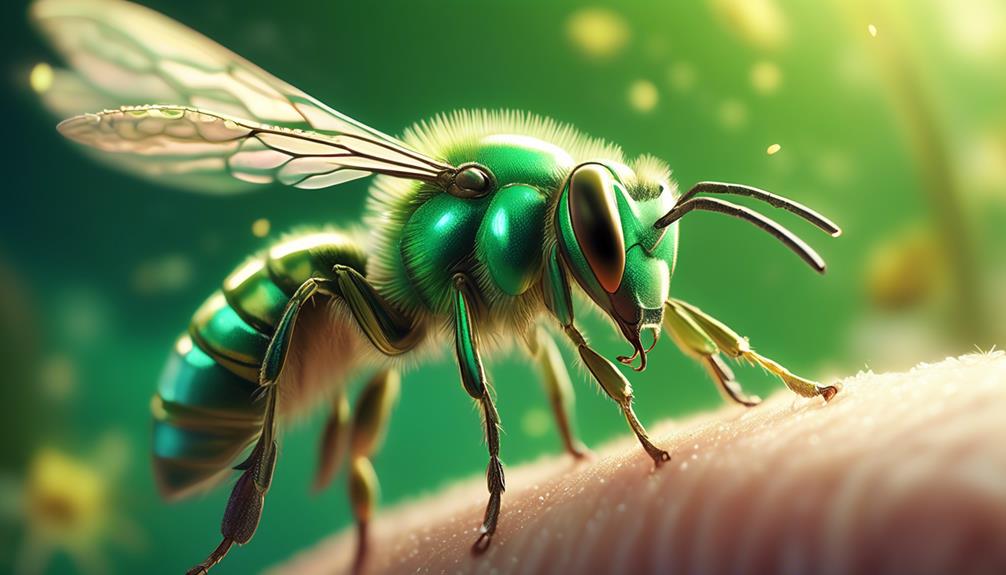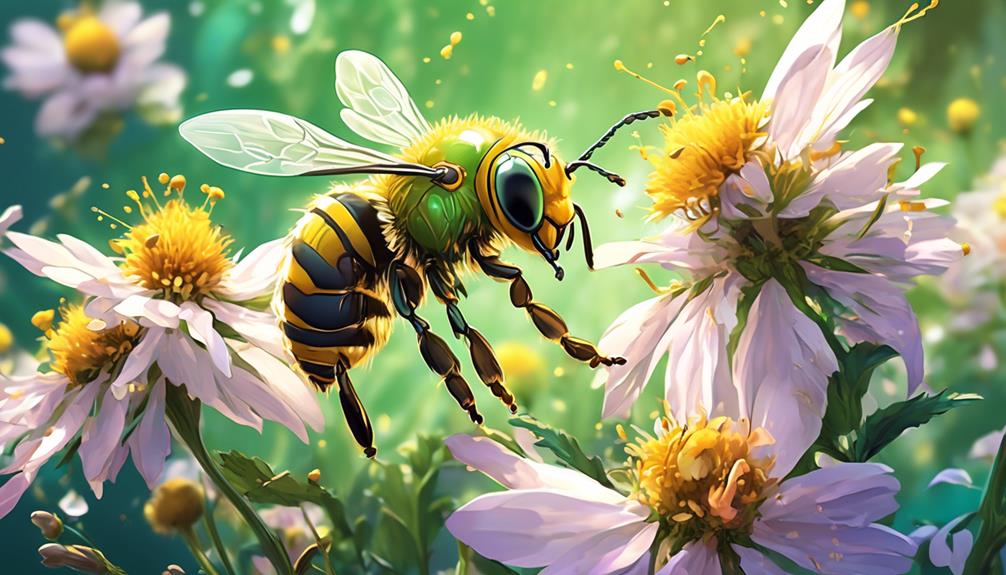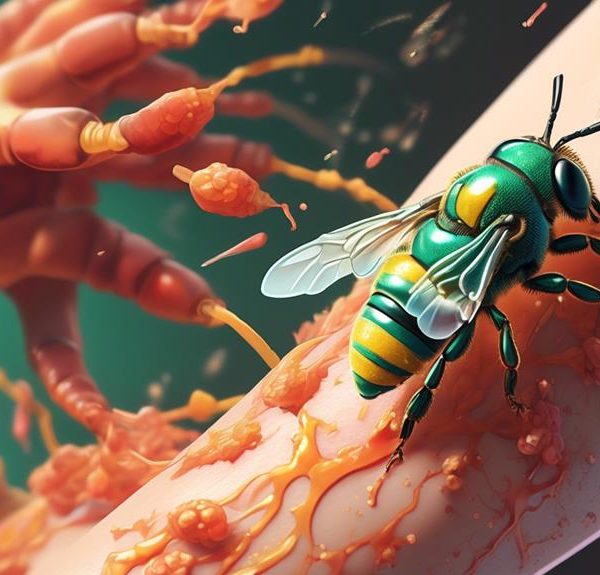Bees attracted to sweat?' Discover the intriguing world of sweat bees and whether their fascination with perspiration leads to a sting.

What Are Sweat Bees and Do They Sting
You've heard the phrase 'bees to honey,' but what about 'bees to sweat?'
Yes, there's a group of the buzzing critters, known as sweat bees, that are more interested in your perspiration than any sweet nectar. They've earned their name due to their unusual attraction to human and animal sweat, and they're found all over the world.
But before you start worrying about these bees crashing your summer workouts, you might be wondering if these sweat-loving insects pose a threat. Should you fear a sting from these unique creatures?
Let's explore this intriguing topic further.
Key Takeaways
- Sweat bees are attracted to human sweat because of the salts it contains.
- Not all sweat bees sting, only the females can.
- Sweat bee stings are less painful than honeybee stings.
- People allergic to bee stings should be cautious around sweat bees.
Understanding the Sweat Bee

You might be surprised to know that there are over 1000 species of sweat bees, all with their unique behaviors and appearances. They're called 'sweat bees' because they're attracted to human sweat. It's not that they seek out your perspiration for its own sake, but rather, they're after the salts that your sweat contains. Pretty fascinating, right?
Now, these bees aren't like the typical ones you're probably picturing. They're quite smaller, and their coloring can range from metallic green to dull brown. Don't mistake their small size for insignificance, though. These little guys play a crucial role in pollinating our plants, especially in areas where there aren't as many honeybees.
It's also worth noting that not all sweat bees sting. The females can, but they usually won't unless they feel threatened. And even if they do sting, it's far less painful than a honeybee sting. The males, on the other hand, can't sting at all.
The Unique Attraction to Sweat

While it might seem strange, sweat bees are drawn to your perspiration due to the salts it contains, which are vital for their survival. Now, you're probably wondering why they can't just get these salts from other sources. You see, many natural sources of salt aren't easily accessible to these tiny creatures. Your sweat, on the other hand, is a readily available, easy-to-consume source.
You might notice these bees more when you're out exercising or on hot days when you're sweating. Don't worry, they're not after you, just your sweat. They're also attracted to the moisture your body exudes, which helps them stay hydrated. So, in a way, you're like a walking, talking, sweating oasis for these little guys.
But before you start feeling like a bee buffet, let's get one thing straight. Sweat bees aren't aggressive. They won't sting unless provoked. So, next time you see one buzzing around you, take a breath, stay calm, and remember, they're just after your sweat, not you. It's a strange relationship, but one that's crucial for the survival of these fascinating insects.
Sweat Bees' Global Distribution

Despite their peculiar affinity for human sweat, sweat bees aren't confined to one region – they're found globally. You'll find these fascinating creatures in various parts of the world, from the dry deserts of Africa to the dense rainforests of South America, and even in the chilly regions of the Arctic Circle.
Sweat bees are incredibly adaptable and have evolved to survive in diverse climates and habitats. Here are three reasons why you should admire their global presence:
- Adaptability: Sweat bees can survive in almost any environment. They're versatile and resilient, showing us that life can find a way, even in the harshest conditions.
- Biodiversity: Their global distribution contributes to the planet's biodiversity. The numerous species of sweat bees play different roles in their respective ecosystems, promoting a balanced and thriving environment.
- Pollination: Sweat bees are unsung heroes of pollination. They help in the reproduction of plants, contributing to the beauty and productivity of our world.
Sweat Bee Behavior and Life Cycle

Let's dive into the intriguing world of sweat bees, exploring their unique behaviors and cyclical life stages.
These tiny creatures aren't only known for their attraction to human sweat, but also for their distinctive life cycle and social structures.
Sweat bees are solitary insects, each female building and provisioning her own nest. However, their social behavior can vary, as some species display semi-social or even highly social behaviors. They're industrious, working from dawn to dusk to gather pollen and nectar for their larvae.
Now, let's examine their life cycle. It begins with the female digging a burrow where she lays her eggs. She then provisions each egg with a ball of pollen and nectar, which will feed the larva after it hatches. The larva then pupates, transforming into an adult bee over several weeks. This process is synchronized with the seasons, ensuring that adult bees emerge during the warmer months when flowers, their food source, are abundant.
Understandably, you might wonder why they're attracted to human sweat. It's simple. Sweat provides them with the salts they need for survival. So, while they might be a nuisance, remember they're just trying to live their lives, like all creatures.
Quite fascinating, isn't it?
The Truth About Sweat Bee Stings

You might be surprised to learn that sweat bees do sting, but there's more to the story than just that. Unlike their infamous cousins, the honey bee and yellow jacket, sweat bee stings are usually far less painful.
- Severity: Typically, a sweat bee sting is likened to a mild pinprick. It's discomforting yet bearable. A slight redness and swelling may occur, but these symptoms usually disappear within a day or two.
- Frequency: Sweat bees aren't aggressive and they don't sting unless provoked. So if you leave them be, they'll do the same for you. Furthermore, only female sweat bees can sting. It's not their go-to defense mechanism as they'd rather fly away than fight.
- Risk: People who are allergic to bee stings should be cautious around sweat bees. Although their sting is mild, it can cause allergic reactions in some individuals.
Conclusion
So, you've learned about sweat bees, their unique affinity for sweat, their global presence, behavior and life cycle.
They're not your typical bees, right?
Now, about their sting – yes, they can sting but it's usually mild. Remember, sweat bees are more interested in your sweat than causing you harm.
So, next time you see a sweat bee, don't panic. They're just doing their thing, and you should too.


